Novartis Bundle
How did Novartis, a global healthcare giant, come to be?
Delve into the fascinating Novartis SWOT Analysis and uncover the compelling story of Novartis, a leading Swiss pharmaceutical company. From its humble beginnings to its current status as a global healthcare innovator, the Novartis history is a testament to strategic foresight and relentless scientific pursuit. Explore the Novartis timeline and discover the key milestones that shaped this pharmaceutical company into the industry leader it is today.
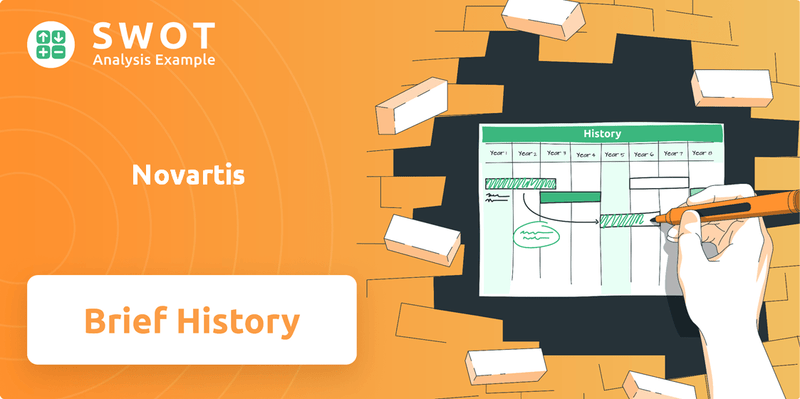
The Novartis company's origins, though rooted in the 18th century, culminated in a significant merger in 1996, marking a pivotal moment in its evolution. This Swiss pharmaceutical powerhouse, Novartis AG, quickly established itself through strategic acquisitions and a commitment to groundbreaking research. Understanding the brief history of Novartis reveals the company's resilience and its enduring impact on global healthcare, driven by continuous innovation and a focus on addressing unmet medical needs.
What is the Novartis Founding Story?
The genesis of Novartis AG, a leading pharmaceutical company, is rooted in a significant merger. This Swiss pharmaceutical giant officially came into existence on March 7, 1996.
This formation was the result of a merger between Ciba-Geigy and Sandoz Laboratories. The merger was valued at roughly $30 billion in stock swaps.
Both Ciba-Geigy and Sandoz had their roots in Basel, Switzerland, which became the natural choice for the headquarters of the newly formed entity, a status it maintains as of 2024.
The merger of Ciba-Geigy and Sandoz in 1996 created Novartis, aiming to combine strengths in healthcare. This strategic move was a response to the evolving pharmaceutical industry.
- Ciba-Geigy's origins trace back to 1758 with Johann Rudolf Geigy-Gemuseus.
- Sandoz was established in 1886 by Dr. Alfred Kern and Edouard Sandoz, initially in dyes.
- The merger was driven by a vision to boost innovation and global market position.
- Novartis aimed to create a more focused and powerful entity.
Ciba-Geigy's history began in 1758 when Johann Rudolf Geigy-Gemuseus started trading in materials, chemicals, dyes, and drugs in Basel. Sandoz was founded in 1886 by Dr. Alfred Kern and Edouard Sandoz as a chemical company in Basel, initially focusing on dyes before expanding into pharmaceuticals. This merger was a strategic move to strengthen their position in the global market. The goal was to combine their extensive research and development capabilities and product portfolios. This strategic consolidation was a response to the changing competitive environment in the pharmaceutical company, aiming to create a more focused and powerful entity. For further insights, consider exploring the Growth Strategy of Novartis.
Novartis SWOT Analysis
- Complete SWOT Breakdown
- Fully Customizable
- Editable in Excel & Word
- Professional Formatting
- Investor-Ready Format
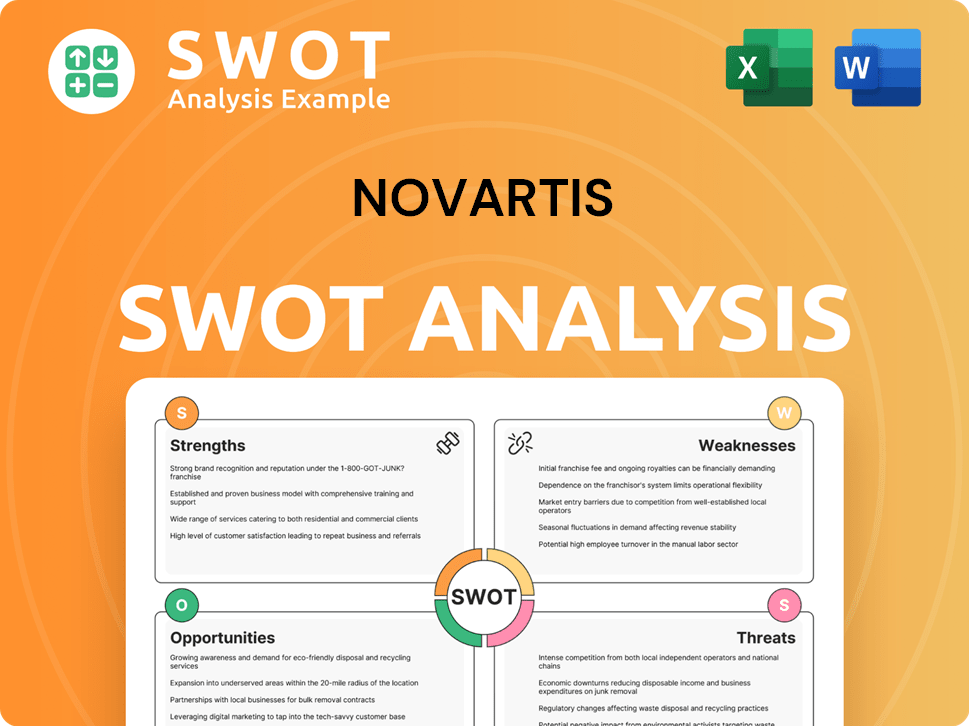
What Drove the Early Growth of Novartis?
The early years of the Novartis company, following its formation in 1996, were marked by a strategic shift towards healthcare. This involved divesting from non-core areas, which allowed the company to focus on becoming a leading innovative medicines provider. This strategic realignment was crucial in shaping the Novartis timeline and its future direction within the pharmaceutical company landscape.
During its early growth, Novartis expanded its global research capabilities. This included opening international research centers in locations like Cambridge, Massachusetts, and Shanghai. These centers helped to accelerate the company's research and development efforts, supporting its innovation timeline.
The company actively acquired external entities to strengthen its research pipeline. In 2001, Novartis acquired the consumer health division of Bristol-Myers Squibb. By 2005, Sandoz, the generics division, became a global leader through acquisitions such as Hexal AG and Eon Labs.
In April 2025, Novartis announced a planned $23 billion investment over five years in US-based manufacturing and R&D infrastructure. This investment includes new manufacturing facilities and a biomedical research hub. The company's focus has evolved to encompass four core therapeutic areas: cardiovascular-renal-metabolic, immunology, neuroscience, and oncology, alongside investments in cutting-edge platforms.
These expansions are expected to create nearly 1,000 new jobs at Novartis and approximately 4,000 additional US jobs. This strategic move aims to strengthen its supply chain and support its US growth outlook. The company is committed to producing its key medicines end-to-end in the US, reflecting its ongoing evolution. Learn more about the brief history of Novartis by reading this article.
Novartis PESTLE Analysis
- Covers All 6 PESTLE Categories
- No Research Needed – Save Hours of Work
- Built by Experts, Trusted by Consultants
- Instant Download, Ready to Use
- 100% Editable, Fully Customizable
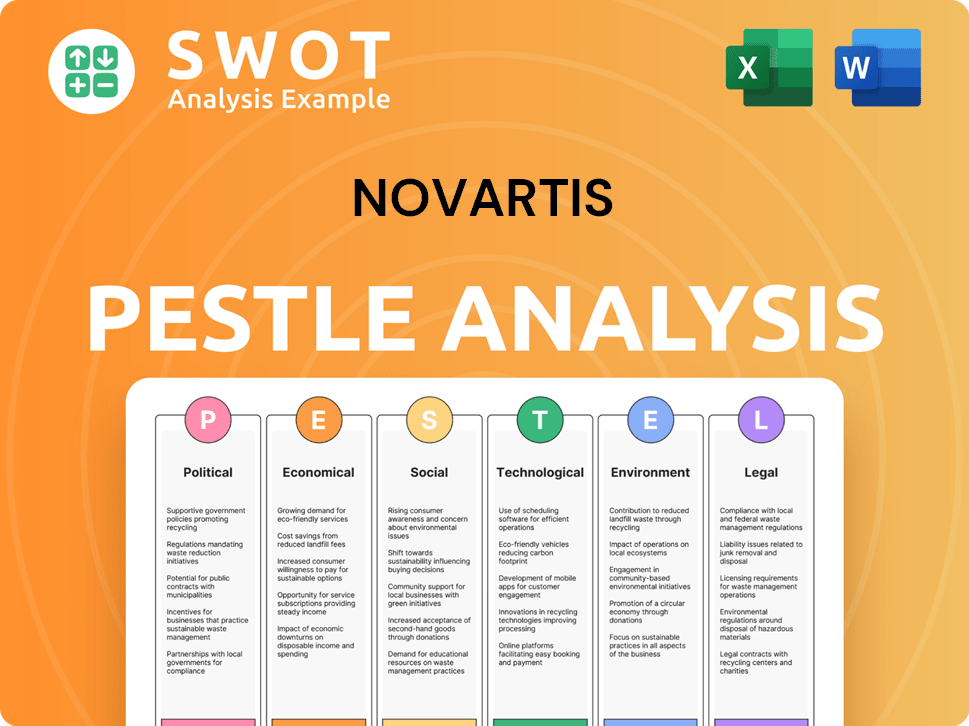
What are the key Milestones in Novartis history?
The Novartis company has a rich history marked by significant milestones and strategic shifts. A key event was the October 2023 spin-off of Sandoz, transforming Novartis into a 'pure-play' innovative medicines company, focusing on high-value medicines and accelerating growth in areas like xRNA, radioligand therapy, and gene and cell therapy.
| Year | Milestone |
|---|---|
| 2023 | Spin-off of Sandoz, focusing on innovative medicines. |
| 2024 | Acquisition of Mariana Oncology and Anthos Therapeutics, bolstering the pipeline. |
| 2024-2025 | FDA approval of Pluvicto and Fabhalta in key markets. |
Novartis has consistently demonstrated innovation, leading to the development of groundbreaking products. The company is investing in cutting-edge platforms such as gene therapy, radioligand therapy, and xRNA, and has made several strategic acquisitions to strengthen its pipeline.
Recent innovation milestones include the FDA approval of Pluvicto for pre-taxane mCRPC, and approvals for Fabhalta (iptacopan) in C3G in major markets. Positive Phase III data for OAV101 IT in spinal muscular atrophy further showcases the company's innovation.
In 2024 and early 2025, Novartis acquired Mariana Oncology for $1 billion upfront and Anthos Therapeutics for $925 million upfront. A strategic collaboration with Dren Bio for up to $3 billion was also established.
Novartis continues to invest heavily in R&D, with a $23 billion US investment planned over five years. The company is focused on early-stage deals, signing 30 deals in 2024 to bolster growth.
Despite its achievements, Novartis faces challenges, including generic competition and currency volatility. Additionally, regulatory hurdles and supply chain risks pose potential disruptions to growth. To address these issues, Novartis is focusing on operational excellence and disciplined capital allocation.
Generic competition for key drugs like Entresto, Tasigna, and Promacta is expected to erode sales by an estimated $1.2 billion annually starting mid-2025. This impacts the company's financial performance.
Currency volatility presents a challenge, potentially causing a 2% drag on core operating income if current exchange rates persist. This impacts the company's financial performance.
Potential delays in late-stage programs, like remibrutinib, could disrupt growth timelines. This can impact the company's future revenue streams.
Novartis Business Model Canvas
- Complete 9-Block Business Model Canvas
- Effortlessly Communicate Your Business Strategy
- Investor-Ready BMC Format
- 100% Editable and Customizable
- Clear and Structured Layout
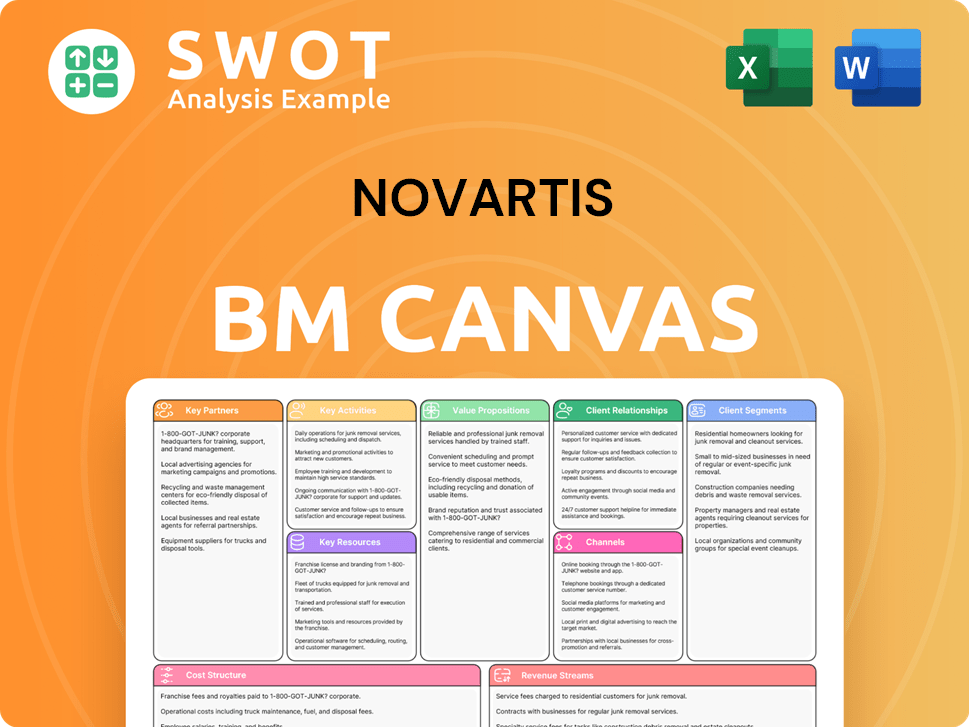
What is the Timeline of Key Events for Novartis?
The Novartis history is marked by significant milestones, from its roots in 1758 with Johann Rudolf Geigy-Gemuseus's trading in Basel, Switzerland, to the formation of the pharmaceutical giant through the 1996 merger of Ciba-Geigy and Sandoz Laboratories. Key events include the 2000 NYSE listing, acquisitions like the consumer health division of Bristol-Myers Squibb in 2001, and the 2023 spin-off of Sandoz, transforming it into a pure-play innovative medicines company. The company has shown strong performance with its 2024 financial results.
| Year | Key Event |
|---|---|
| 1758 | Johann Rudolf Geigy-Gemuseus begins trading in Basel, Switzerland, marking early roots. |
| 1886 | Chemical company Kern & Sandoz is established in Basel. |
| 1996 | Novartis is formed through the merger of Ciba-Geigy and Sandoz Laboratories on March 7. |
| 2000 | Novartis floats on the NYSE on May 11. |
| 2001 | Acquires the consumer health division of Bristol-Myers Squibb. |
| 2004 | The Novartis Institute for Tropical Disease opens in Singapore. |
| 2005 | Sandoz becomes the world leader in generic pharmaceuticals after acquiring Hexal AG and Eon Labs. |
| 2019 | The eye-care division Alcon is spun off into an independent company in April. |
| 2023 | Successfully spins off Sandoz in October, transforming into a pure-play innovative medicines company. |
| 2024 | Reports strong financial performance with a 12% increase in net sales and a 22% rise in core operating income. |
| 2025 | Novartis shareholders approve the 28th consecutive dividend increase to CHF 3.50 per share for 2024. |
| 2025 | Announces a planned $23 billion investment over five years in US-based manufacturing and R&D infrastructure. |
| 2025 | Reports strong Q1 2025 results with net sales of $13.2 billion, up 15% in constant currency, and raises full-year 2025 guidance. |
The Novartis company is focused on accelerating growth through innovation and new product launches. Priority brands like Kisqali, Kesimpta, and Leqvio are anticipated to drive growth through 2030 and beyond. The company plans to continue its strategy of pursuing bolt-on acquisitions to bolster growth in the 2030 and beyond period.
Novartis is increasing investments in cutting-edge platforms such as gene therapy, radioligand therapy, and xRNA. They are pushing for deeper market penetration in key geographies like the US, China, Germany, and Japan. The company also aims to achieve carbon neutrality in Scope 1 and 2 emissions by 2025 and slash emissions by 90% from 2022 levels by 2030.
Novartis has raised its full-year 2025 guidance, expecting high single-digit sales growth and low double-digit growth in core operating income. The company reported Q1 2025 results with net sales of $13.2 billion, up 15% in constant currency. The company is focused on expanding its global reach, entering new markets, and strengthening its presence in existing ones.
Novartis aims to achieve carbon neutrality in Scope 1 and 2 emissions by 2025 and slash emissions by 90% from 2022 levels by 2030. They also plan to switch to 100% renewable electricity by 2025. These initiatives support their commitment to improving patient outcomes and asserting a strong position in global markets.
Novartis Porter's Five Forces Analysis
- Covers All 5 Competitive Forces in Detail
- Structured for Consultants, Students, and Founders
- 100% Editable in Microsoft Word & Excel
- Instant Digital Download – Use Immediately
- Compatible with Mac & PC – Fully Unlocked
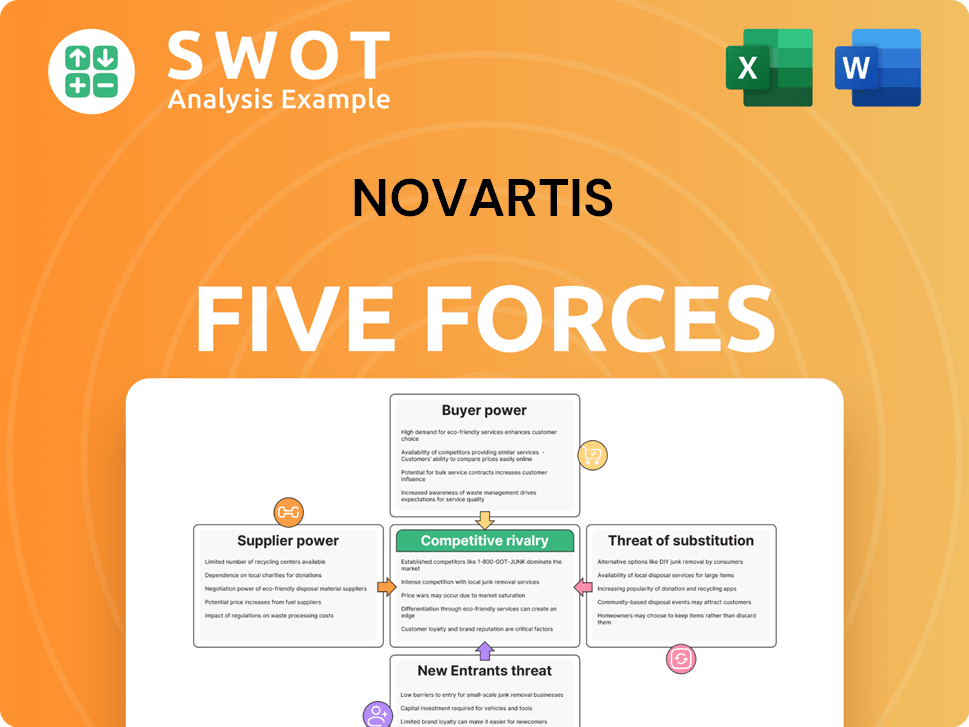
Related Blogs
- What is Competitive Landscape of Novartis Company?
- What is Growth Strategy and Future Prospects of Novartis Company?
- How Does Novartis Company Work?
- What is Sales and Marketing Strategy of Novartis Company?
- What is Brief History of Novartis Company?
- Who Owns Novartis Company?
- What is Customer Demographics and Target Market of Novartis Company?
Disclaimer
All information, articles, and product details provided on this website are for general informational and educational purposes only. We do not claim any ownership over, nor do we intend to infringe upon, any trademarks, copyrights, logos, brand names, or other intellectual property mentioned or depicted on this site. Such intellectual property remains the property of its respective owners, and any references here are made solely for identification or informational purposes, without implying any affiliation, endorsement, or partnership.
We make no representations or warranties, express or implied, regarding the accuracy, completeness, or suitability of any content or products presented. Nothing on this website should be construed as legal, tax, investment, financial, medical, or other professional advice. In addition, no part of this site—including articles or product references—constitutes a solicitation, recommendation, endorsement, advertisement, or offer to buy or sell any securities, franchises, or other financial instruments, particularly in jurisdictions where such activity would be unlawful.
All content is of a general nature and may not address the specific circumstances of any individual or entity. It is not a substitute for professional advice or services. Any actions you take based on the information provided here are strictly at your own risk. You accept full responsibility for any decisions or outcomes arising from your use of this website and agree to release us from any liability in connection with your use of, or reliance upon, the content or products found herein.